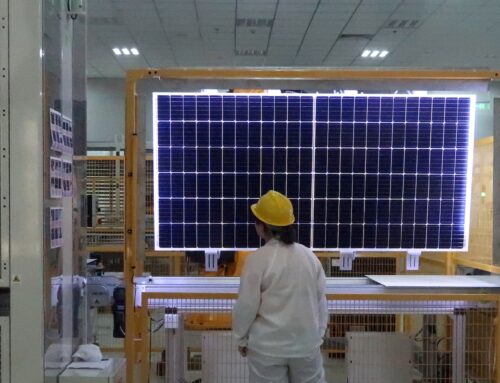How China Took Over the World’s Clean Energy Boom
October 8, 2025
Back in May, we reported that China is on the way to becoming the world’s first ‘‘electrostate’’ thanks to the ongoing EV boom coupled with rapid industrial electrification. According to a study by the International Energy Agency (IEA), China’s electrification rate has hit 30%, significantly ahead of the U.S. and the EU, where the electrification rate has plateaued at ~22% in recent years.
Last year, electric vehicles (EVs) made up approximately 47.9% of the total passenger car sales in China, a huge increase from 2020, when plug-in EVs accounted for just 6.3% of total sales. However, China’s booming renewable energy sector is not only being driven by a large domestic market but also by robust green energy exports. Indeed, China’s green tech exports hit a record $20 billion in August alone, creating a ‘‘new energy system.’’
Interestingly, China’s clean energy sector is doing brisk business with less developed economies even as the U.S. retreats from the clean energy race. In fact, 51% of China’s EV sales growth in the current year has come from nations outside the Organisation for Economic Co-operation and Development (OECD). Exports to ASEAN (Association of Southeast Asian Nations) surged 75% during the first eight months of 2025, while EV exports to Africa nearly tripled, led by Morocco and Nigeria with the West African nation recording a six-fold surge in purchases. Meanwhile, exports to the Middle East jumped 72% while sales to Latin America grew 11%. But it’s not just electric vehicles. China exported 46 GW of solar PV equipment in August, more than Australia’s total installed capacity.
Related: Russia Says It Is Boosting Oil Production
“China’s electrotech is becoming the basis of the new energy system, with continued cost reductions driving faster growth than ever, especially in emerging economies,” Ember analysts wrote.
And, it’s all being driven by a virtuous cycle of falling renewable energy prices, an economic phenomenon where increased adoption and production lead to lower costs, which in turn encourages more adoption and production, creating a self-sustaining downward spiral of prices and upward surge in deployment. This cycle is driven by technological advancements, economies of scale in manufacturing, increased competition, and more efficient installation and operation of renewable systems. China’s value of green energy esports has actually declined by 47% in dollar terms since its March 2023 peak, with the country’s solar manufacturers currently embroiled in a vicious price war. Since 2020, China has seen dramatic price reductions in both solar panels and EV batteries, with solar module prices falling significantly. An average EV battery pack price in China dropped by about 30% in 2024, contributing to a nearly 10% drop in average BEV SUV prices for the year.
Free Markets
Last year, former U.S. Treasury Secretary Janet Yellen lamented that China’s national underwriting for energy and other companies has been creating oversupply and distorting global markets. China has pumped in more than $50 billion in wafer-to-solar panel production lines, 10x more than Europe, and also controls a staggering ~95% of the world’s polysilicon and wafer supply. China’s installed capacity for renewable energy, including wind and solar, reached 1,410 gigawatts last year, surpassing coal. In 2023, the IEA warned of the dangers of the world relying so heavily on China’s solar and clean energy sector.
However, Beijing now appears increasingly willing to play by free market rules.
Earlier in the year, the South China Morning Post reported that the country is looking to modernize its renewable energy sector by leaving the prices of clean energy to the whims of the markets rather than being dictated by the government. China’s National Development and Reform Commission (NDRC) and the National Energy Administration (NEA) have issued a notice about deepening the “market-oriented reform” wherein the price of on-grid electricity generated from renewable sources such as wind and solar, previously fixed, would be determined by market mechanisms.
“With the large-scale development of new energy, the fixed pricing for on-grid electricity cannot accurately reflect market supply and demand and does not share its responsibility for regulating the power system,” the authorities said.
In an effort to balance the new market-driven pricing, Beijing will implement “balancing payments,” a system comparable to the UK’s contracts for difference. This mechanism ensures power producers receive compensation when electricity prices fall below an agreed level and repay excess profits when rates exceed a certain threshold.
The move underscores Beijing’s shift away from subsidy-driven incentives as its renewable energy sector continues to mature. China has been criticized for its highly protectionist policies for its renewable energy sector and blamed for causing a global glut.
By Alex Kimani for Oilprice.com
More Top Reads From Oilprice.com:
Oilprice Intelligence brings you the signals before they become front-page news. This is the same expert analysis read by veteran traders and political advisors. Get it free, twice a week, and you’ll always know why the market is moving before everyone else.
You get the geopolitical intelligence, the hidden inventory data, and the market whispers that move billions – and we’ll send you $389 in premium energy intelligence, on us, just for subscribing. Join 400,000+ readers today. Get access immediately by clicking here.
Terms and Privacy Policy
Search
RECENT PRESS RELEASES
Related Post




